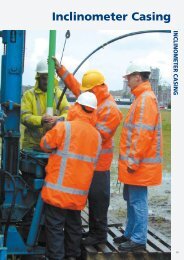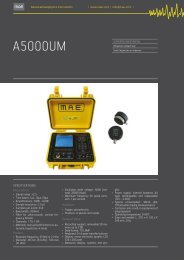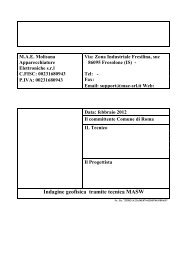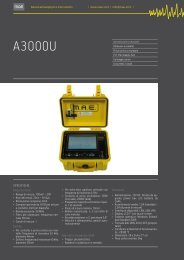Untitled
Untitled
Untitled
Create successful ePaper yourself
Turn your PDF publications into a flip-book with our unique Google optimized e-Paper software.
› Mae 29<br />
VIBRALOG<br />
SUPPORTED INVESTIGATION<br />
Passive seismic acquisition<br />
Seismic vibration monitoring<br />
Nakamura method<br />
mae-srl.it/go/vibralog<br />
24 bit seismograph for passive seismic<br />
activity, particularly indicated<br />
for recording micro-earthquakes or<br />
seismic vibrations. The data acquisition<br />
methods (timed or with trigger<br />
threshold) are set through the software<br />
easily and quickly. Equipped<br />
with graphic display, keyboard, memory<br />
support of Secure Digital (S.D.)<br />
type and internal battery, seismograph<br />
VIBRALOG is particularly easy<br />
to use also in less favourable environments<br />
and conditions.<br />
Thanks to the MAE data acquisition<br />
and conversion card, based on one<br />
single A/D signal converter for each<br />
inlet channel (SST technology), it allows<br />
to obtain the best possible resolution<br />
when acquiring the data for<br />
each single inlet channel and it allows<br />
to record and graphically visualize<br />
up to 4 channels coming from<br />
seismic sensors (with single component<br />
or tridimensional).<br />
Thanks to its dynamic characteristics,<br />
the instrument is particularly<br />
suitable to determine the resonance<br />
frequency of the site, through<br />
the H/V ratio method and to acquire<br />
transitional events (caused by natural<br />
seismicity or human activities)<br />
with the purpose to calculate the<br />
maximum speeds of the stresses suffered<br />
by a structure.<br />
SPECIFICATIONS<br />
• Converters: 24 bit resolution, sigma- delta<br />
technology<br />
• Dynamic range: 144 dB (theoretical)<br />
• Maximum distortion: +/-0.0010%<br />
• Band width: 2Hz-30KHz<br />
• Common mode rejection: 110dB at 60Hz<br />
• Diaphony: -120dB at 20Hz<br />
• Noise threshold of the programmable amplifier:<br />
27nV<br />
• Maximum range of inlet signal: +/-5V<br />
• Inlet impedance at 1000 samples/second:<br />
20MΩ<br />
• Amplification levels: 0dB, 6dB, 12dB, 18dB,<br />
24dB, 30dB, 36dB that can be set singularly<br />
for each channel<br />
• Anti-alias filter: -3dB, 80% of Nyquist frequency,<br />
-80dB<br />
• Pre-trigger time: from 1% to 50% of the event<br />
duration<br />
• Sampling frequencies 100, 500, 1000, 2000<br />
samples per second; 250c/s in continuous recording<br />
• Sampling intervals: 0.5, 1.0, 2.0, 4.0, 10.0 ms<br />
• Length of the event recorded: from 512 to<br />
21504 samples (215sec. at 100c/s or 10.7sec.<br />
at 2000c/s). Depending on SD capacity in continuous<br />
recording<br />
• Delay: not available<br />
• Channels: 3 + 1 optional. Possibility to use<br />
from 1 to the maximum number of channels<br />
installed for each acquisition<br />
• Test on instruments: only in the laboratory.<br />
Internal self-calibration of the converters prior<br />
to each acquisition<br />
• Digital filters: selected automatically based<br />
on the sampling frequency<br />
• Data storage: on removable SD memory, up<br />
to 2 GB<br />
• Trigger: 10 threshold levels for each channel<br />
(minimum 8mV – max. 5V). Up to 3 coincidence<br />
combinations between channels<br />
• Data format: SEG-2 standard (32-bit long integer),<br />
BIN convertible in ASCII<br />
• Power supply: 12V DC. Internal batteries of<br />
2.5Ah. Average absorption: 150mA.<br />
• Environmental conditions: -20/80°C<br />
• Display: mono-chromatic graphic LCD 320 x<br />
240 pixel<br />
• Keyboard: 6 charge-transfer buttons<br />
• Sizes: 23.8 x 6.7 x 14.1 cm<br />
• Weight: 1.4 Kg (cables and sensors excluded)









